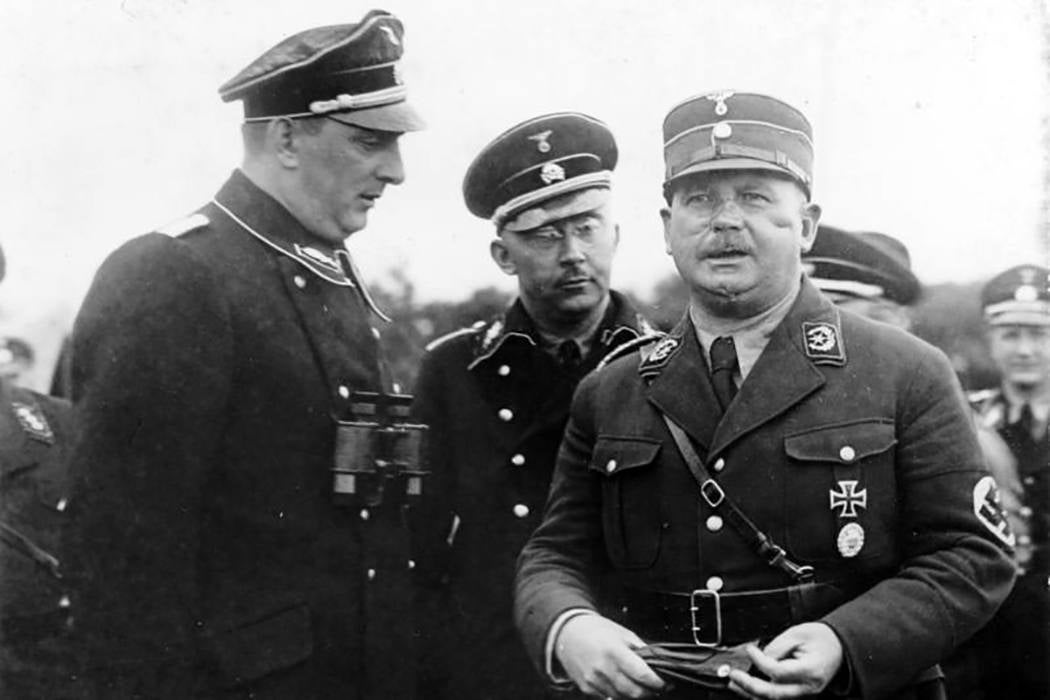A man in make-up and pearls condemning transgender people may seem counterintuitive, but Milo Yiannopoulos is hardly the first gay reactionary. The case of Ernst Röhm, the highest-ranking gay Nazi, presents an interesting study in the construction and containment of masculinity by the right.
Röhm was Hitler’s right-hand man as head of the Sturmabteilung (SA, the Brownshirts), the Nazi paramilitary wing. Instrumental in the rise of the party via the street-fighting and extra-judicial murders of the late 1920s and early 1930s, Röhm’s sexual orientation was no secret after the mid-1920s. Hitler either ignored it or said it was immaterial, depending on who he was talking to, including other Nazis.
Röhm opposed his party’s stand on Paragraph 175 of the German penal code, which made male homosexual acts illegal. This made some German homosexuals think he might ultimately tone down the Nazi stance. That was always wishful thinking, but became especially moot after 1934’s “Night of the Long Knives,” when Röhm and others were massacred as Hitler consolidated his power. (Earlier, the Social Democrats, one of the few parties to campaign for the repeal of Paragraph 175, showed itself willing to gay-bait Röhm.)
As Eleanor Hancock explains, Röhm, his face scarred from war wounds, stressed a hyper-masculinity to counteract contemporary views of homosexuality as feminine. A First World War veteran, Rohm “attached paramount importance to the values of militarized masculinity.” This aligned with Nazi views of the homosocial Männerbund. Such all-male organizations of warrior-comrades were supposed to be united under the banner of discipline and order against the threatening “wave” of the bourgeoisie, women, Jews, socialists, Bolsheviks, all of whom represented weakness, chaos, and disorder—in short, the Weimar Republic. Röhm suggested that the line between homosocial and homosexual, however, was potentially fluid.
Weekly Digest
Hancock says that Röhm “challenged the privileging of heterosexual over homosexual masculinities. If Röhm’s masculinity reassured some Nazis, it threatened others. His open homosexuality may have threatened the psychological security of some other National Socialists, creating a form of ‘male homosexual panic.'” She goes further, wondering if “the purge of the SA and the killing of Röhm represented the literal objective correlative for the suppression and repression of the homosexual desires in their own Nazism?”
Even before Ernst Röhm was murdered, the Nazis had begun cracking down on homosexuality, banning organizations, burning books, and arresting the first of some 100,000. Around 15,000 gay people were sent to concentration camps, where some were experimented upon in bizarre efforts to find a “cure” for sexual orientation, a foreshadowing of American psychological and later fundamentalist efforts to try the same thing.








[…] rights go back more than a century. A historian looks at “transvestite” clubs in 1920s Berlin, gay Nazis, and the question of […]
[…] lack of reliable records. But a conservative estimate is that there were many tens of thousands to one hundred thousand arrests during the war period […]
[…] lack of reliable records. But a conservative estimate is that there were many tens of thousands to one hundred thousand arrests during the war period […]
[…] lack of reliable records. But a conservative estimate is that there were many tens of thousands to one hundred thousand arrests during the war period […]
[…] lack of reliable records. But a conservative estimate is that there were many tens of thousands to one hundred thousand arrests during the war period […]
[…] lack of reliable records. But a conservative estimate is that there were many tens of thousands to one hundred thousand arrests during the war period […]
[…] lack of reliable records. But a conservative estimate is that there were many tens of thousands to one hundred thousand arrests during the war period […]
[…] lack of reliable records. But a conservative estimate is that there were many tens of thousands to one hundred thousand arrests during the war period […]
[…] lack of reliable records. But a conservative estimate is that there were many tens of thousands to one hundred thousand arrests during the war period […]
[…] sounds good to manipulate, but it’s consistent to nothing but power. That’s what makes gay nazis and non-white collaborators. It’s always […]
[…] be fascist because they are *token identity*. (That’s historically false: 1930’s Nazis had gay leaders until they took power and killed them – and their Japanese allies weren’t […]
[…] altfurries, while privately regarding them as disposable tools, would be consistent with history. Gay nazi leaders were powerful until they were purged. (The most consistent thing about fascists is being two-faced […]
[…] he wasn’t just a homosexual. He was a gay right activist who opposed his party’s stand on Paragraph 175 of the German penal code, which prohibited homosexual […]
[…] Maar een conservatieve schatting is dat er alleen al in de oorlogsperiode vele tienduizenden tot honderdduizend arrestaties hebben […]
[…] references Ernst Röhm and Edmund Heines, two gay men who were still part of the Nazi […]
[…] references Ernst Röhm and Edmund Heines, two gay men who were still part of the Nazi […]
[…] references Ernst Röhm and Edmund Heines, two gay men who were still part of the Nazi […]
[…] that may even stand apart as unique in all Islamic history. In the movement’s own replay of the Nazi-era ‘Ernst Röhm Affair’ it had emerged that a group of FOI soldiers (known as the ‘Task Force’), and who were […]
[…] “Brownshirts”) from 1931 to 1934, is noted as having been “the highest-ranking gay Nazi” (Wills). Another high-ranking Nazi known to have been gay was Edmund Heines (1897–1934), who Hitler […]
[…] records. But a conservative estimate is that there were many tens of thousands to one hundred thousand arrests during the war period […]